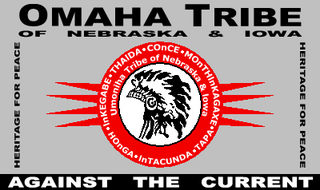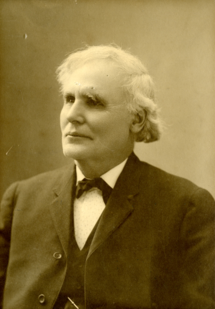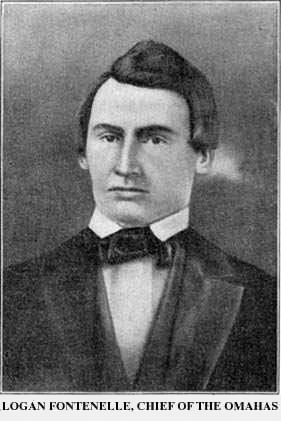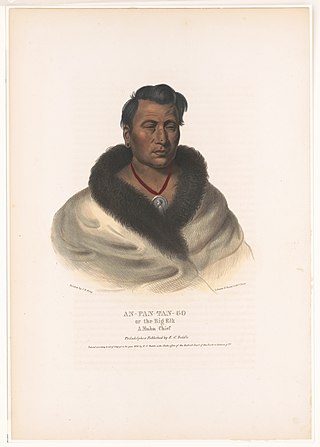History
Despite their original reservation having been established in 1858, the Ponca suffered decades of broken treaties, a lack of financial support from the U.S. Government, and ongoing attacks by the neighboring Sioux, with whom they were sworn enemies. In 1875 a Ponca agent visited President Ulysses S. Grant to discuss moving the Ponca to the Indian Territory in present-day Oklahoma. Grant agreed to the move if the Ponca were willing. When the agent returned to Nebraska, Standing Bear and other tribal members signed an agreement to move to the Indian Territory. The agreement also allowed several Ponca chiefs to select a new reservation there. In 1877 the Ponca leaders made arrangements to visit the Indian Territory and select a site for a new reservation.
Ponca Trail of Tears
In early 1877, ten Ponca leaders left for the Osage Reservation in Indian Territory to select a site for the new Ponca Reservation. Upon arriving, they found no Osage leaders present, so no land agreements were signed. Standing Bear and the other leaders decided they wanted to return home, which infuriated the Indian agent who accompanied them. In February the group of chiefs decided to return on their own. The group spent much of their travels on the open prairie, going for days without rations. They arrived at the Ponca Reservation more than three months later in April 1877.
On their arrival, the group met with their Indian Agent, who had orders to remove the tribe by force to Oklahoma. The tribe was split about leaving; those willing left in mid-April. A month later Standing Bear and the remainder of the tribe left after a military unit from Fort Omaha arrived. Nine people died on the journey, including Standing Bear's daughter. Prairie Flower died of consumption and was buried at Milford, Nebraska. White Buffalo Girl, daughter of Black Elk and Moon Hawk, also died and was buried near Neligh, Nebraska, with the people of Neligh providing a Christian burial for the girl and crafting an oak cross over the gravesite. Black Elk asked that the grave of his daughter be honored, and in 1913 the town of Neligh erected a marble monument that is still there. [3]
Several of the leaders of the tribe went back to Nebraska, only to be imprisoned at Fort Omaha. General George Crook, commander of the Department of the Platte, imprisoned the contingent against his own best concerns. He tipped off Thomas Tibbles of the Omaha Daily Herald , who brought national attention to the plight of the tribe. This eventually led the U.S. government to grant the tribe two reservations; one in Nebraska and one in Oklahoma. [4] [5] [6] [7]

The Sioux or Oceti Sakowin are groups of Native American tribes and First Nations people from the Great Plains of North America. The Sioux have two major linguistic divisions: the Dakota and Lakota peoples. Collectively, they are the Očhéthi Šakówiŋ, or "Seven Council Fires". The term "Sioux", an exonym from a French transcription of the Ojibwe term Nadowessi, can refer to any ethnic group within the Great Sioux Nation or to any of the nation's many language dialects.

Indian Territory and the Indian Territories are terms that generally described an evolving land area set aside by the United States government for the relocation of Native Americans who held original Indian title to their land as an independent nation-state. The concept of an Indian territory was an outcome of the U.S. federal government's 18th- and 19th-century policy of Indian removal. After the American Civil War (1861–1865), the policy of the U.S. government was one of assimilation.

The Treaty of Fort Laramie is an agreement between the United States and the Oglala, Miniconjou, and Brulé bands of Lakota people, Yanktonai Dakota, and Arapaho Nation, following the failure of the first Fort Laramie treaty, signed in 1851.

The Ponca people are a nation primarily located in the Great Plains of North America that share a common Ponca culture, history, and language, identified with two Indigenous nations: the Ponca Tribe of Indians of Oklahoma or the Ponca Tribe of Nebraska.

The Osage Nation is a Midwestern American tribe of the Great Plains. The tribe began in the Ohio and Mississippi river valleys around 700 B.C. along with other groups of its language family, then migrated west in the 17th century due to Iroquois incursions.

Standing Bear was a Ponca chief and Native American civil rights leader who successfully argued in U.S. District Court in 1879 in Omaha that Native Americans are "persons within the meaning of the law" and have the right of habeas corpus, thus becoming the first Native American judicially granted civil rights under American law. His first wife Zazette Primeau (Primo), daughter of Lone Chief, mother of Prairie Flower and Bear Shield, was also a signatory on the 1879 writ that initiated the famous court case.

The Omaha Tribe of Nebraska are a federally recognized Midwestern Native American tribe who reside on the Omaha Reservation in northeastern Nebraska and western Iowa, United States. There were 5,427 enrolled members as of 2012. The Omaha Reservation lies primarily in the southern part of Thurston County and northeastern Cuming County, Nebraska, but small parts extend into the northeast corner of Burt County and across the Missouri River into Monona County, Iowa. Its total land area is 307.03 sq mi (795.2 km2) and the reservation population, including non-Native residents, was 4,526 in the 2020 census. Its largest community is Pender.

The Quapaw or Arkansas, officially the Quapaw Nation, is a U.S. federally recognized tribe comprising about 5,600 citizens. Also known as the Ogáxpa or “Downstream” people, their ancestral homelands are traced from what is now the Ohio River, west to the Mississippi River to present-day St. Louis, south across present-day Arkansas and eastern and southern Oklahoma. The government forcibly removed them from Arkansas Territory in 1834. The tribal capital is Quapaw, Oklahoma.

Francis La Flesche was the first professional Native American ethnologist; he worked with the Smithsonian Institution. He specialized in Omaha and Osage cultures. Working closely as a translator and researcher with the anthropologist Alice C. Fletcher, La Flesche wrote several articles and a book on the Omaha, plus more numerous works on the Osage. He made valuable original recordings of their traditional songs and chants. Beginning in 1908, he collaborated with American composer Charles Wakefield Cadman to develop an opera, Da O Ma (1912), based on his stories of Omaha life, but it was never produced. A collection of La Flesche's stories was published posthumously in 1998.

Susette La Flesche, later Susette LaFlesche Tibbles and also called Inshata Theumba, meaning "Bright Eyes", was a well-known Native American writer, lecturer, interpreter, and artist of the Omaha tribe in Nebraska. La Flesche was a progressive who was a spokesperson for Native American rights. She was of Ponca, Iowa, French, and Anglo-American ancestry. In 1983, she was inducted into the Nebraska Hall of Fame. In 1994, she was inducted into the National Women's Hall of Fame.

Thomas Henry Tibbles was an American abolitionist, writer, journalist, Native American rights activist, and politician who was born in Ohio and lived in various other places in the United States, especially Nebraska. Tibbles played an important role in the trial of Standing Bear, a legal battle which led to the liberation of the Ponca tribe from the Indian territory in Oklahoma in the year 1879. This landmark case led to important improvements in the civil rights of Native Americans throughout the country and opened the door to further advancement.

Joseph LaFlesche, also known as E-sta-mah-za or Iron Eye, was the last recognized head chief of the Omaha tribe of Native Americans who was selected according to the traditional tribal rituals. The head chief Big Elk had adopted LaFlesche as an adult into the Omaha and designated him in 1843 as his successor. LaFlesche was of Ponca and French Canadian ancestry; he became a chief in 1853, after Big Elk's death. An 1889 account said that he had been the only chief among the Omaha to have known European ancestry.

The Ponca Tribe of Indians of Oklahoma, also known as the Ponca Nation, is one of two federally recognized tribes of Ponca people. The other is the Ponca Tribe of Nebraska. Traditionally, peoples of both tribes have spoken the Omaha-Ponca language, part of the Siouan language family. They share many common cultural norms and characteristics with the Omaha, Osage, Kaw, and Quapaw peoples.

The Ponca Tribe of Nebraska is one of two federally recognized tribes of the Ponca people. The other is the Ponca Tribe of Indians of Oklahoma. As of 2023, the Ponca Tribe of Nebraska’s total population is 5,334 citizens, of which 1,923 reside in Nebraska.

Logan Fontenelle, also known as Shon-ga-ska, was a trader of Omaha and French ancestry, who served for years as an interpreter to the US Indian agent at the Bellevue Agency in Nebraska. He was especially important during the United States negotiations with Omaha leaders in 1853–1854 about ceding land to the United States prior to settlement on a reservation. His mother was a daughter of Big Elk, the principal chief, and his father was a respected French-American fur trader.

Big Elk, also known as Ontopanga (1765/75–1846/1848), was a principal chief of the Omaha tribe for many years on the upper Missouri River. He is notable for his oration delivered at the funeral of Black Buffalo, the maternal grandfather of Crazy Horse, in 1813.
A Half-Breed Tract was a segment of land designated in the western states by the United States government in the 19th century specifically for Métis of American Indian and European or European-American ancestry, at the time commonly known as half-breeds. The government set aside such tracts in several parts of the Midwestern prairie region, including in Iowa Territory, Nebraska Territory, Kansas Territory, Minnesota Territory, and Wisconsin Territory.

Native American tribes in the U.S. state of Nebraska have been Plains Indians, descendants of succeeding cultures of indigenous peoples who have occupied the area for thousands of years. More than 15 historic tribes have been identified as having lived in, hunted in, or otherwise occupied territory within the current state boundaries.

The Cherokee Commission, was a three-person bi-partisan body created by President Benjamin Harrison to operate under the direction of the Secretary of the Interior, as empowered by Section 14 of the Indian Appropriations Act of March 2, 1889. Section 15 of the same Act empowered the President to open land for settlement. The Commission's purpose was to legally acquire land occupied by the Cherokee Nation and other tribes in the Oklahoma Territory for non-indigenous homestead acreage.

















